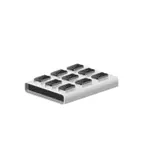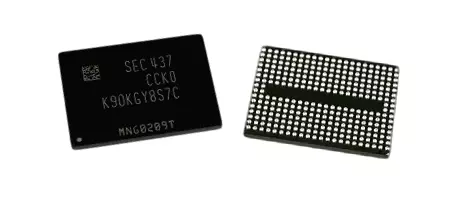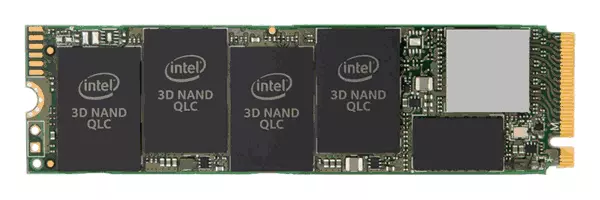
In this review for novice users, details about the types of flash memory used in SSD, their advantages and disadvantages and which options may be more preferable when purchasing a solid-state drive. It can also be useful: Setting up SSD for Windows 10, how to transfer Windows 10 with HDD to SSD, how to find out the SSD speed.
Flash Types used in SSD for home use
A flash memory is used in SSD, which is a specially organized memory cells based on semiconductors, which may differ in type.In general terms, Flash memory used in SSD can be divided into the following types.
- According to the principle of reading-write, almost all commercially available consumer SSDs have a type of NAND.
- According to the storage technology, the memory is divided into SLC (SINGLE-LEVEL CELL) and MLC (Multi-Level Cell). In the first case, the cell can store one bit of information, in the second - more than one bit. At the same time, in SSD for home use, you will not encounter SLC memory, only MLC.
In turn, TLC also belongs to the type of MLC, the difference is that instead of 2 bits of information can store 3 bits of information in the memory cell (instead of TLC, you can meet 3-bit MLC or MLC-3 designation). That is, TLC is a subspecies of the MLC memory.
What is better - MLC or TLC
In general, MLC memory has advantages over TLC, the main of which:
- Higher work speed.
- Longer service life.
- Less power consumption.
The disadvantage is a higher price of MLC compared to TLC.

However, it should be borne in mind that we are talking about the "general case", in real devices presented on sale you can see:
- Equal speed (other things being equal) for SSD with TLC and MLC memory connected via the SATA-3 interface. Moreover, separate TLC memory drives with the PCI-E NVME interface can sometimes be faster than the PCI-E MLC memory storage facilities (however, if we talk about the "top", most expensive and fast SSDs, they are still Usually the MLC memory is used, but also not always).
- Large warranty service life (TBW) for TLC memory of one manufacturer (or one drive line) compared with the MLC memory of another manufacturer (or other SSD line).
- Similarly with power consumption - for example, the SATA-3 drive with the TLC memory can consume ten times less energy than the PCI-E drive with MLC memory. Moreover, for one type of memory and one connection interface, the electricity difference is also very different depending on the specific drive.
And these are not all parameters: speed, service life and energy consumption will also differ from the "generation" of the drive (newer, as a rule, more perfect: Currently, SSD continues to develop and improve), its total volume and amount of free space when using and Even the temperature regime when used (for fast NVME drives).
As a result, a strict and accurate verdict that MLC is better to make a TLC cannot be made - for example, by purchasing a more capacious and new SSD with TLC and the best set of characteristics, you can win in all parameters compared to the acquisition of the MLC drive at a similar price, t .. All parameters should be taken into account, and start an analysis from an affordable purchase budget (for example, if we talk up to 10,000 rubles with a budget, usually the TLC memory drives will be preferable to MLC for both SATA and PCI-E devices).
QLC memory SSD drives
From the end of last year, solid-state drives with QLC memory appeared (Quad-Level Cell, i.e. 4 bits in one memory cell), and probably in 2019 such discs will be more and more, and their cost promises to be attractive.
The final products are characterized by the following pluses and minuses compared to MLC / TLC:
- Less cost per gigabyte
- Great exposure to wear memory and, theoretically, the high probability of error when writing data
- Less data recording speed

It is still difficult to talk about specific figures yet, but some examples from the already available on sale can be studied: for example, if you take approximately similar M.2 SSD drives with a volume of 512 GB from Intel based on QLC 3D NAND and TLC 3D NAND, study the characteristics declared by the manufacturer see:
- 6-7 thousand rubles against 10-11 thousand rubles. And for the cost of 512 GB TLC, you can purchase 1024 GB QLC.
- The stated volume of record data (TBW) is 100 TB against 288 TB.
- Record / read speed - 1000/1500 versus 1625/3230 MB / c.
On the one hand, minuses can outweigh the advantages from the cost. On the other, you can take into account such moments: for SATA disks (if only such an interface is available) Speed differences You will not notice and compared to HDD speed gain will be very significant, and the TBW parameter for QLC SSD is 1024 GB (which in my The example is as much as the TLC SSD at 512 GB) already 200 TB (more voluminous solid storage devices "live" longer, which is due to how they are recorded on them).
Memory V-NAND, 3D NAND, 3D TLC, etc.
In the descriptions of SSD drives (especially when it is about Samsung and Intel) in stores and reviews you can meet the designations of V-NAND, 3D-NAND and similar for memory types.

Such a designation suggests that flash memory cells are placed on chips in several layers (in simple cell chips are placed in one layer, more - on Wikipedia), and this is the same TLC memory or MLC, only not everywhere it is obviously: For example, for SSD from Samsung, you only see that V-NAND memory is used, however, the information that V-Nand TLC is used in the EVO line, and the Pro - V-NAND MLC line is not always indicated. Also now there are CLCs QLC 3D NAND.
Is it better to 3D NAND than "flat" (Planar) memory? It is cheaper in production and tests say that today for the TLC memory option with multi-layer placement is usually more efficient and reliable (more so, Samsung declares that the devices of their production V-NAND TLC has the best performance characteristics and Service life than Planar MLC). However, for MLC memory, including within the framework of a single manufacturer's devices, this may not be. Those. Again, it all depends on the specific device, your budget and other parameters that should be studied before purchasing SSD.
I would glad to recommend Samsung 970 Pro at least 1 TB as a good option for a home computer or laptop, but you are usually purchased cheaper discs for which you have to carefully study the entire set of characteristics and compare them with what is required from the drive.
Hence the lack of a clear answer, and which type of memory is better. Of course, the capacious SSD with MLC 3D NAND on a set of characteristics will win, but only until these characteristics are discussed in the deployment of the storage price. If you take into account this parameter, then I do not exclude that QLC drives will be preferable for some users, but the Golden Middle is the TLC memory. And, what kind of SSD you did not choose, I recommend seriously referring to backing up important data.
